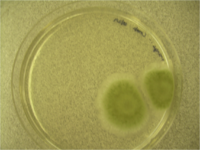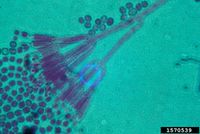Penicillium expansum
| Literature database |
|---|
| 256 articles sorted by: |
| • year (descending) |
| • research topics |
| • countries/regions |
| • host plants |
| • list of antagonists |

Author(s): H.J. Larsen
Source: Wikimedia Commons
Penicillium expansum Link 1809 - (blue mold)
The fungus has a world-wide distribution and causes post harvest mould on apple, other fruits, legumes and various other stored products. It might form toxins (e.g. the carcinogenic patulin) which can affect humans. Several countries have set a patulin limit in apple juice and WHO recommends a limit of 50 µg per litre. Losses of apple in storage have been estimated at 30% in Brazil and at more than US$ 4 million in the U.S.A. (1992).
Fruits often become infected in orchards and vineyards. The optimal temperature range for infections is 15-25 °C. The fungus is airborne and infects fruits through small wounds like those caused by insects or during harvests. Infections might also occur during washing the fruits after harvest. Initially, infected fruits develop brown lesions on the surface. A brownish soft rot follows and blueish-green spores are formed on the surface.
| Vernacular names | |
|---|---|
| • Deutsch: | Blaufäule des Apfel |
| • English: | blue mold |
| • Español: | marchitez común de los frutales |
| • Français: | moisissure bleue |
| • Português: | bolor azul |
For management, avoiding injuries during harvest and sanitation (removal of infected fruits) in the orchards is recommended. Post harvest treatments include fungicides, coating the fruits with an antagonistic yeast and hot water dipping.
The spores can persist in the environment until the following season. Conidia are spherical to slightly ellipsoid, blueish-green and have a diameter of around 3 µm.
For a review see Luciano-Rosario et al. (2020).
- Other images of Penicillium expansum (Wikimedia Commons and IPM Images - click to enlarge)

